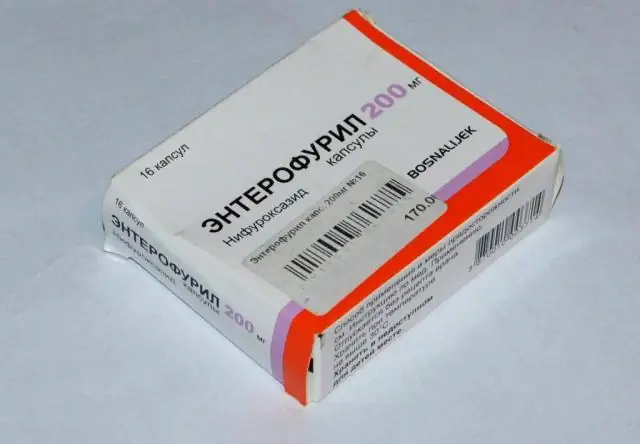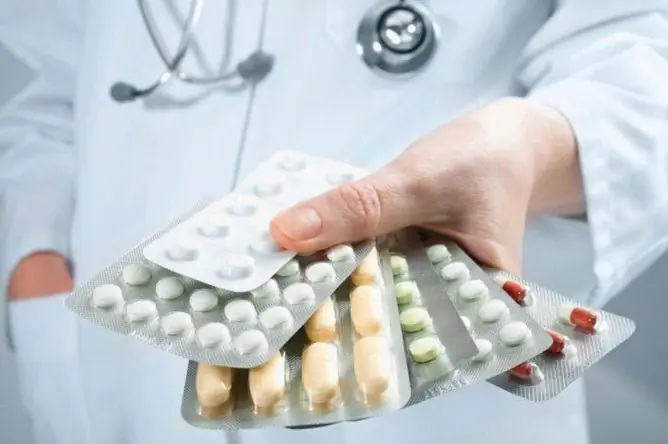- Author Rachel Wainwright [email protected].
- Public 2023-12-15 07:39.
- Last modified 2025-11-02 20:14.
Antistax
Antistax: instructions for use and reviews
- 1. Release form and composition
- 2. Pharmacological properties
- 3. Indications for use
- 4. Contraindications
- 5. Method of application and dosage
- 6. Side effects
- 7. Overdose
- 8. Special instructions
- 9. Application during pregnancy and lactation
- 10. Use in childhood
- 11. Drug interactions
- 12. Analogs
- 13. Terms and conditions of storage
- 14. Terms of dispensing from pharmacies
- 15. Reviews
- 16. Price in pharmacies
Latin name: Antistax
ATX code: C05CA
Active ingredient: grapes red leaves extract dry
Producer: Ginsana (Switzerland), Delpharm Reims (France), Boehringer Ingelheim Pharma (Germany)
Description and photo update: 2019-02-09
Prices in pharmacies: from 607 rubles.
Buy

Antistax is a phytopreparation from the group of angioprotectors and microcirculation correctors for the treatment of venous circulation disorders.
Release form and composition
Antistax is available in capsules with a red gelatinous shell, in the form of a gel for external use and in the form of a cooling spray.
The capsule contains a brownish powder with a characteristic odor, including:
- Dry extract of grape leaves - 180 mg;
- Colloidal anhydrous silicon oxide - 9.35 mg;
- Dextrose - 38.25 mg;
- Corn starch - 8.4 mg;
- Magnesium stearate - 2.6 mg;
- Talc - 8.4 mg.
The capsule shell consists of gelatin, sodium lauryl sulfate, titanium dioxide (E171), iron oxide red dye (E172), yellow iron oxide dye (E172), purified water.
The capsules are packaged in blisters of 10 pieces, the pack contains 2, 3, 5, 10 or 16 blisters and instructions for the use of Antistax.
Gel for external use contains: Vitis vinifera - extract of red grape leaves, water, ethyl alcohol, glycerin ester, coconut fatty acid ester, sodium hydroxide, erythrosine and caramel dyes and lemon oil. Produced in tubes (125 ml), one tube in a cardboard box.
Antistax Cooling Foot Spray contains: grape leaf extract, water, carbamide, propylene glycol, isopropyl myristate, panthenol, hydrogenated castor oil (PEG-40), diethyl ether, methylparaben, butylphenyl perfume, linalool, citral, hexyl-cinnamal, 940 propanol, methylpropionate, geraniol, citronellol. It is produced in spray bottles (75 mg), in a cardboard box 1 bottle.
Pharmacological properties
Pharmacodynamics
The extract of red grape leaves contains pharmacologically active flavonoids, the main ones being isoquercetin and quercetin glucuronide.
Antistax has a protective effect on the vascular endothelium, helping to stabilize the membranes and increase the elasticity of blood vessels, and also normalizes vascular permeability. By reducing the permeability of the vascular wall for plasma, water or proteins from the vessels into the surrounding tissue, the formation of edema is slowed down, and the already existing edema is reduced.
Indications for use
The use of Antistax is recommended for the prevention and treatment of symptoms of chronic venous insufficiency (CVI) with varicose veins, including edema, a feeling of heaviness in the legs, paresthesias (tingling and numbness), pain.
Contraindications
The drug should not be taken in case of hypersensitivity to its components, as well as children and adolescents under 18 years of age.
Antistax is not recommended for use during pregnancy and lactation, since studies on the safety of the drug in this group have not been conducted.
Antistax, instructions for use: method and dosage
Antistax capsules are taken orally, before meals, 1 capsule 2 times a day. With severe venous insufficiency, the dose can be increased to 4 capsules per day. They must be swallowed whole with plenty of water. The course of application of Antistax is 12 weeks.
For the prevention of exacerbations, it is recommended to take the drug 2 times a year for 4 weeks, 2 capsules 1 time per day.
It is more effective to use the gel simultaneously with capsules. The gel is applied in the morning and in the evening, massaging movements from the lower leg to the thigh.
Spray Antistax is used as an auxiliary component of treatment to create a cooling effect. It should be sprayed holding the bottle vertically from a distance of 10 cm, shaking vigorously several times before use. After application, the product must be rubbed into the skin of the legs with massage movements from the bottom up.
Side effects
Antistax rarely causes allergic reactions (in about 1% of all use cases).
Side effects from the digestive system in the form of stomach discomfort and nausea - less than 1% of cases.
Overdose
There is information about isolated cases of overdose of Antistax in the form of capsules, while specific symptoms that require treatment have not been identified. No serious adverse drug-related side effects have been reported.
special instructions
If there is no effect of treatment within 6 weeks, it is imperative to consult a doctor to correct therapy.
Patients with diabetes mellitus should take into account that 1 capsule of Antistax contains 7.5 mg of glucose, respectively, in 4 capsules (maximum daily dose) its content is 30 mg.
In case of sudden formation (especially in one leg) of tension, skin redness, swelling, pain, burning, you should immediately consult a doctor. The listed signs may indicate the development of thrombophlebitis. In this case, the course of treatment can be resumed only after medical advice.
Antistax gel and spray should not be used in the presence of wound surfaces on the lower extremities. It is important to avoid contact with mucous membranes and eyes.
Application during pregnancy and lactation
It is not recommended to use Antistax during pregnancy and lactation, since the efficacy and safety of the drug during these periods of a woman's life has not been established.
Pediatric use
Antistax is not prescribed for patients under 18 years of age.
Drug interactions
There is no information.
Analogs
Analogs of Antistax are: Agapurin, Anavenol, Vasoket, Venarus, Venitan, Venolife, Venoflebin, Hepatrombin, Detralex, Doxilek, Indovazin, Lioton 1000, Ralofekt, Rutin, Stilamin, Troxerutin, Ultraan, Tsinnasan, Eskuzan.
Terms and conditions of storage
Antistax capsules and spray should be stored in a dry place at temperatures between 15 ° and 25 ° C, and the gel should be stored in the refrigerator.
The shelf life of the drugs is 3 years.
Terms of dispensing from pharmacies
Available without a prescription.
Reviews about Antistax
Reviews about Antistax are different. Many users were satisfied with the effect of the drug. It is indicated that the use of capsules reduces swelling and heaviness in the legs. In other cases, it is noted that the agent does not provide the claimed therapeutic effect. Patients write about Antistax in the form of a gel that it is easy to apply, odorless, relieves puffiness and fatigue. The disadvantages include a sticky film that forms on the skin at the site of application of the gel, a delayed onset of action. The cost is assessed as high.
Price for Antistax in pharmacies
The approximate price for Antistax is:
- Capsules: 556-640 rubles. (20 pcs. In a package), 964-1075 rubles. (50 pcs. In a package) or 1497-1688 rubles. (100 pcs per pack);
- Gel for external use - 804-878 rubles. (1 tube of 125 ml).
Antistax: prices in online pharmacies
|
Drug name Price Pharmacy |
|
Antistax 180 mg capsule 20 pcs. 607 r Buy |
|
Antistax cooling gel with double effect cosmetic cooling gel 125 ml 1 pc. RUB 699 Buy |
|
Antistax cosmetic gel gel 125 ml 1 pc. 850 RUB Buy |
|
Antistax 180 mg capsule 50 pcs. 1033 RUB Buy |
|
Antistax 180 mg capsule 100 pcs. 1613 RUB Buy |

Maria Kulkes Medical journalist About the author
Education: First Moscow State Medical University named after I. M. Sechenov, specialty "General Medicine".
Information about the drug is generalized, provided for informational purposes only and does not replace the official instructions. Self-medication is hazardous to health!






